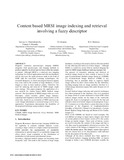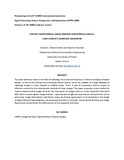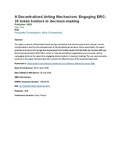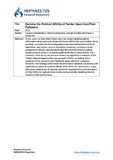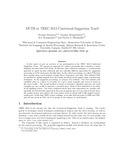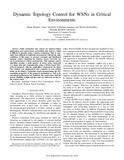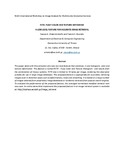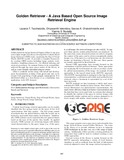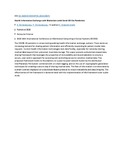Browsing Conference papers by Title
Now showing items 15-34 of 85
-
Content based MRSI image indexing and retrieval involving a fuzzy descriptor
(Institute of Electrical and Electronics Engineers (IEEE), United States, 2010)Magnetic resonance spectroscopic imaging (MRSI) integrates both spectroscopic and imaging methods to produce spatially localized spectra from within the sample or patient. Although MRSI is a relatively new imaging technology ...
-
Content based radiology image retrieval using a fuzzy rule based scalable composite descriptor
(Springer Nature, 2009)The rapid advances made in the field of radiology, the increased frequency in which oncological diseases appear, as well as the demand for prevailing medical checks, led to the creation of a large database of radiology ...
-
A Decentralized Voting Mechanism: Engaging ERC-20 token holders in decision-making
(IEEE, 2020-07-20)This paper presents a Blockchain-based voting mechanism that has the potential to disrupt current voting systems and fuel the development of decentralized governance. More specifically, the paper presents a study on the ...
-
Deriving the Political Affinity of Twitter Users from Their Followers
(IEEE, 2018)In this work, we show that Twitter users can reveal valuable political information about particular Nodes of Interest (NOIs) they opt to follow. More precisely, we utilize an interesting graph projection method and a series ...
-
Distributed Multi-Robot Coverage using Micro Aerial Vehicles
(IEEE (Computer Society), 2013)In this paper we present a solution to the problem of positioning a team of Micro Aerial Vehicles for a surveillance task in an environment of arbitrary and unknown morphology. The problem is addressed taking into account ...
-
Double Mobile sinks Architecture for WSN Data Gathering and Critical Events Detection
(IEEE, 2020-06-17)Data gathering and critical events detection are two essential functionalities for Wireless Sensor Network (WSN). In this paper, we propose double mobile sinks network architecture, where two mobile sink nodes visit the ...
-
DUTH at TREC 2013 Contextual Suggestion Track
(2013)In this report we give an overview of our participation in the TREC 2013 Contextual Suggestion Track. We present an approach for context processing that comprises a newly designed and fine-tuned POI (Point Of Interest) ...
-
DUTH at TREC 2015 Clinical Decision Support Track
(2015)In this report we give an overview of our participation in the TREC 2015 Clinical Decision Support Track. We present two approaches for pre-processing and indexing of the open-access PubMed articles, and four methods for ...
-
Dynamic Topology Control for WSNs in Critical Environments
(IEEE, 2011)Plant automation and control are mission-critical applications and require timely and reliable data delivery, which is difficult to provide using a wireless technology. This is especially more difficult in industrial ...
-
Dynamic Two-Stage Image Retrieval from Large Multimodal Databases
(Springer-Verlag, 2011)Content-based image retrieval (CBIR) with global features is notoriously noisy, especially for image queries with low percentages of relevant images in a collection. Moreover, CBIR typically ranks the whole collection, ...
-
Empowering Responsible Online Gambling by Real-time Persuasive Information Systems
(IEEE, 2018-05)Online gambling, unlike other mediums of problem-atic and addictive behaviours, such as tobacco and alcohol, offers unprecedented opportunities for building information systems that are able to monitor and understand a ...
-
Enhancing Deniability against Query-Logs
(Springer, 2011)We propose a method for search privacy on the Internet, focusing onenhancing plausible deniability against search engine query-logs. The method ap-proximates the target search results, without submitting the intended query ...
-
Extracting Intention from Web Queries– Application in eHealth Personalization
(Springer, Cham, 2015-06)Personalizing healthcare applications requires capturing patient specific information, including medical history, health status, and mental aspects such as behaviors, intentions, and attitudes. This paper presents a ...
-
FCTH: Fuzzy color and texture histogram. A low level feature for accurate image retrieval
(IEEE (Institute of Electrical and Electronics Engineers , United States), 2008)This paper deals with the extraction of a new low level feature that combines, in one histogram, color and texture information. This feature is named FCTH - Fuzzy Color and Texture Histogram - and results from the combination ...
-
Fusion vs. Two-Stage for Multimodal Retrieval
(Springer, 2011)We compare two methods for retrieval from multimodal collections. The first is a score-based fusion of results, retrieved visually and textually. The second is a two-stage method that visually re-ranks the top-K results ...
-
A fuzzy rule based control system for fast line following robots.
(IEEE, 2020-06-17)This paper focuses on the optimization of the line-tracking and following control technique used in high speed autonomous movable IoT devices such as line-following robotic vehicles. A fusion of a new pro-active / feed-forward ...
-
General Data Format Security Extensions for Biomedical Signals
(2018)Biosignals recorded using personal health devices and stored in General Data Format (GDF) are vulnerable when the data is transferred, processed and stored to the external servers. The aforementioned vulnerabilities influence ...
-
Generalized setting equations for the memory elements of sequential machines. Self-independence criteria.
(Informatica, 1976)This paper is concerned with formal derivation of generalized setting (excitation) equations of the flip-flop memory elements of a sequential machine. The equations are expressed in terms of four normalized transition ...
-
Golden Retriever - A Java Based Open Source Image Retrieval Engine
(ACM, 2013)Golden Retriever Image Retrieval Engine (GRire) is an open source light weight Java library developed for Content Based Image Retrieval (CBIR) tasks, employing the Bag of Visual Words (BOVW) model. It provides a complete ...
-
Health Information Exchange with Blockchain amid Covid-19-like Pandemics
(ΙΕΕΕ, 2020-06-17)The COVID-19 pandemic is stress-testing existing health information exchange systems. There exists an increasing demand for sharing patient information and efficiently responding to patient medial data requests. Current ...

